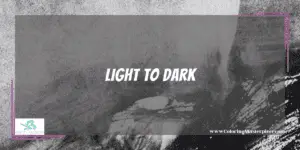Though not as widespread as white paper, coloring on black colored paper is a mesmerizing experience that all colorists should try. Colors both settle and appear differently when placed on a naturally dark background as opposed to a pale and bright background. Because of this, the coloring basics for coloring on black colored paper are applied differently as opposed to coloring over standard white paper.
Setting Yourself Up For Success

First and foremost, you need the right tools for the job. When it comes to black paper, aim for a quality paper. Something thicker like card stock is preferred since the tooth of a thicker paper is strong enough to hold onto a multiplicity of color layers and compliment strong textures. Additionally, if you have a black paper coloring book, then you should be good to go, as most adult coloring books will already have the ideal paper in them for specific book types.
As long as the paper itself is a similar thickness to cart stock, then the tone of the paper will be dark enough. The black color of most black paper is darker than the black colored pencils top quality brands such as Prismacolor and Faber-Castell.
Speaking of which, when it comes to colored pencils, you want to keep quality in mind as well. Anything in the scholastic to professional or artist-level art supply should suffice. Prismacolor and Faber-Castell are always welcome, but they’re not the only two available options. Brands such as Caran d’Ache, Derwent, Spectrum Noir, and Arteza are just as viable if you prefer or own sets in any of these brands. Either way, a colored pencil that has high saturation is the most important part. When it comes to feeling and visual appeal, that’s completely up to the artist!
Lastly, we recommend getting a black eraser. A white eraser on black paper will deface the color and tooth of the paper. Please don’t make that mistake; you deserve good art. Staedtler sells a pretty good black eraser for anywhere between $1.75 to $6.00, depending on where you go. I’ve seen them available at Office Depot, Micheal, Fred Meyer, and even Safeway, and if not in any store, they’re available on Amazon. A black eraser is a good tool for every artist’s toolbox since it’s more useful than you’d think, so do yourself a favor, and just buy one. Think of it as a small key to success.
Sketching The Base
Whether you’re drawing an image on black paper or using a black paper coloring book, the first step is to sketch the highlights and shape of the coloring subject with a white colored pencil. This base highlight layer doesn’t have to be perfect. The function of the base layer is to be a total value map once we begin using color and act as a base coat of primer for the color to layer into.
First, sketch or trace the base highlight layer that will become the tone guide for the coloring section later on. Start with the brightest area of the subject; ideally, this is where the light source is most intense the subject. We recommend coloring lightly in a circular pattern to save the tooth of your paper from being damaged and to spread the pigment on the page.
Coloring A Highlight Guide
Keep in mind you’ll be coloring and drawing layers of white pigment, so the first layer doesn’t have to be perfect. Just color another layer of white smoothly over the first layer, and keep lightly layering the white pencil to achieve higher saturation. The brightest areas of the picture need to be more saturated with a white colored pencil under the color layer. Otherwise, the natural black of the black paper will come through and darken the color value.
On the other side, however, as you sketch or trace, the highlighted base layers should be applied to medium-tone value areas. The natural black of the paper should be more present as you color away from the light source. Instead of coloring three or more layers of white color for high saturation, medium-tone areas typically get away with one to two layers of white color. The medium value of the paper behind a medium-tone color helps pronounce the visual presence of the color in contrast to the black paper background.
Lastly, as colorists finish the sketching base, there is typically less and less white pencil being used. For the darkest areas of the picture, some white is required to lay color over, but it’s more than fine to have larger gaps in the saturation or even place color directly onto the black paper.
Check out more information on paper HERE.
Light to Dark

Now that we have our tonal value map from the base highlight layer let’s color. If you’ve ever colored in a greyscale coloring book, then coloring black paper should feel familiar, and if not, don’t worry; it all revolves around extremely simple building blocks.
We are starting with the lightest color and the lightest tonal value (i.e., light green, light blue, light yellow) color over the whitest layers on the subject. Just like how we started closest to the light source with our highlight guide, we are also going to start with the lightest color values and color over the base layer of white.
The more layers of color you do, the more intense the color will become and slowly darker in value. This is great for when it’s time to start blending and mixing into the medium tonal values such as green, blue, or orange. As more of the black paper starts to show through in the medium tonal ranges, the best compliment is to color medium tones over the paper for a bold presentation of color.
Naturally, as the highlight guide steps into the darkest and least saturated areas of the subject, start layering medium tones into the darkest color tones in the subject, such as dark green, navy, or crimson. As the picture darkens, really layer the color onto the natural black of the paper. And for your darkest sections, let the darkness of the black paper seep through the color more.
Final Shadows and Highlights
After the pigment of the picture has been laid down, the final steps come full circle. It’s time to detail the shadows and highlights. When it comes to shadows, we still want to avoid using black colored pencils since the black of the paper is often darker and will clash with the more muted black of a colored pencil. Instead, you have to play a little jazz with the shadows. What I mean is, that you have two tools to darken the shadows—the black of the paper and burnishing from dark tone color values or dark tone color blends.
Ideally, for the darkest areas, the black paper will be the darkest value, especially if a colorist is using the black paper as a high contrast to the lightness of the subject. If the natural black of the paper isn’t dark enough to weigh the shadow’s value down, then you may need to try burnishing layers of dark tone color into the paper. Keep in mind this will create a colored hue and could ruin your shadow altogether so please do so cautiously.
When it comes to final highlights, just as we did create the highlight guide, we’re going to start with the brightest areas and move to the darkest areas. If possible, use white-colored pencils that have a higher opacity than the white-colored pencils you normally use. The higher opacity will provide the final touches of white pigment while letting the color beneath still shine through the highlighted addition. You can also use a colorless binder pencil. There is no white pigment in the colorless blender, so you won’t get bauble to achieve the same highlights, but it will act as a primer that adds pop to the colors beneath it.
Keep in mind that colorless binders are also used for blending, so they can smudge your colors if you burnish the pencil into the paper. Finally, when it comes to your last layer of highlights, this is also a good opportunity to do high-contrast coloring by putting more white into the highlights that are directly next to your darkest areas. This will make both the highlight and the shadow appear heavier in their respective tones.
Maximize the benefits of coloring with my free adult coloring eBook and sign up for my email newsletter HERE!
Disclaimer: The information provided by ColoringMasterpiece.com (“The Site”) is for general informational purposes only. All information on the Site is provided in good faith, however, we make no representation or warranty of any kind, express or implied, regarding the accuracy, adequacy, validity, reliability, availability, or completeness of any information on the Site. Under no circumstance shall we have any liability to you for any loss or damage of any kind incurred as a result of the use of the Site or Reliance on any information provided on the Site. Your use of the Site and your reliance on any information on the Site is solely at your own risk. This blog post is for educational purposes only and does not constitute legal advice. Please consult a legal expert to address your specific needs.
Terms and Conditions: https://coloringmasterpiece.com/terms-and-conditions/
